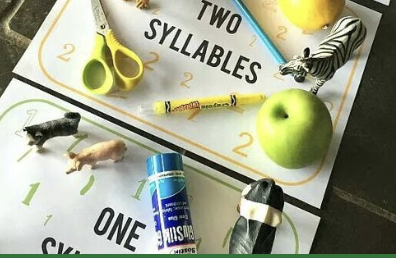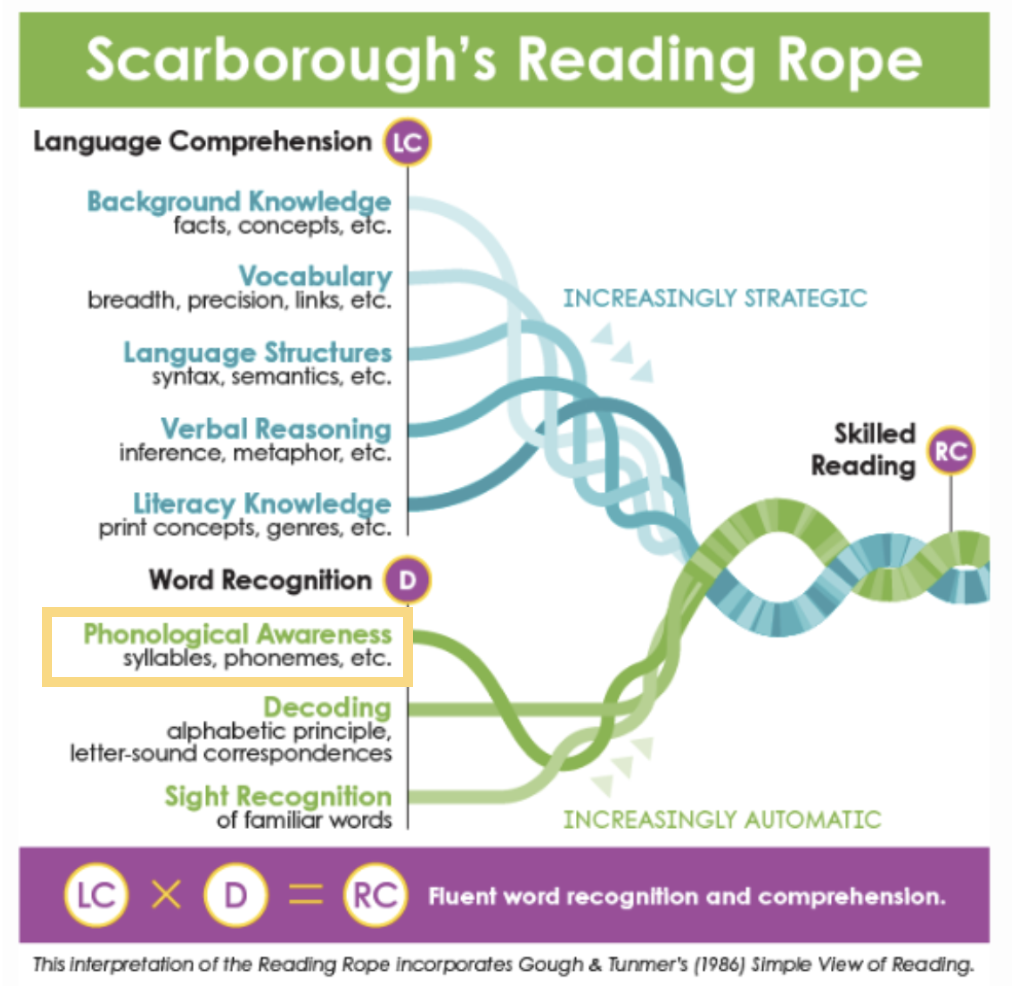Phonological Awareness
Phonological Awareness is the ability to hear and use the sounds of spoken language, including: 1) words 2) syllables, 3) onsets & rimes (the initial phonological unit and the string of letters that follows it, such as /c/ and -at in cat), and phonemes (the smallest unit of sound).
A child’s phonemic awareness – hearing and using the smallest unit of sound – is the best predictor of how well a child will learn to read in the first two years of instruction.
Source: Really Great Reading
All children will benefit from this practice until they are able to hear and use phonemes (smallest unit of sound).
Children might need extra practice here if:
How would I know if my child should practice phonological awareness?
Your child finds it challenging to think of rhyming words for simple words (like sit and fit).
Your child is stumped when you ask how many syllables are in her name.
Your child has never shown any interest in word play, language games, or rhymes.
Activities
-

412 Rhymes
412 Rhymes is a 30-lesson sequence of interactive videos. Each video includes three instructional routines – Rhyme Time, Smash Word, and Letter Sounds. You can set your child up with these lessons that they can do and practice independently.
______
Focus: Rhyming + phonemic awareness.
Driven by: Child
Time: 15 minutes, per lesson
Source: Pittsburg Reads and its affiliates: OpenLiteracy, A+ Schools, and Kinselland
-

Sounder & Friends
Sounder & Friends® The Game introduces children to important phonemic awareness skills in a fun and playful way. Download Sounder & Friends® The Game, available on: the Apple App Store or Google Play.
___
Driven by: Child
Time Required: About 15 minutes per lesson
Sub-Focus: Blending, segmenting, and manipulating sounds
Source: Unleashed Innovation Inc., and Heather Kenny, PhD. and Laura Robbins, M.Ed.
-

Mystery Bag
In Mystery Bag, you can help build your child’s ability to rhyme, using an old book bag filled with random objects. 1. Find things that are of meaning to you or place objects in the bag that will make your child laugh. 2. See how many words your child can think of that rhyme with that object, even if it is not a real word!
___
Driven by: Caregiver
Time Required: ~5 minutes
Sub-Focus: Rhyming
Source: Mrs. Barhorst, a first grade teacher
-

Syllable Scavenger Hunt
In Syllable Scavenger Hunt, you can help your child break words into syllables. 1. Have your child search the house for objects that have 1, 2, 3, 4 or 5 syllables. 2. Then sort them onto pieces of paper labeled with the numbers 1-5.
__
Driven by: Caregiver
Time Required: ~5 minutes
Sub-Focus: Syllable segmentation
Source: Mrs. Barhorst, a first grade teacher
-

Let's Get Physical
In Let’s Get Physical, you can help your child break words into syllables by playing physical games.
For The Syllable Hop: 1. Explain that everyone will hop in time with the syllables of a word. 2. Remind your child what syllables are and model the activity quickly. 3. Depending on what your child understands, this could be a shadow activity – you say the word, model it, and then have your child copy what you did. 4. Say words that your child knows and have fun hopping around!
For Syllable Number Run – 1. Set up a space that has enough room for your kiddo to run around. Even better, take the game outside! 2. Place a 1 in one area, a 2 in a different spot, and a 3 in a third spot. 3. Shout a word and have your kiddo run to the number that represents the correct amount of syllables. Say the word slowly, broken down into syllables, to help your kiddo self-correct.
____
Driven by: Caregiver
Time Required: ~10 minutes
Sub-Focus: Syllable segmentation
Source: Mrs. Barhorst, a first grade teacher
-

Animal Breakfast
In Animal Breakfast, you can help your child identify and match the initial sound in words. 1. You can use stuffed animals or pictures of animals and either real or pretend food. Start out by collecting a number of animals and food items that have the same onset (beginning sound) such as (e.g. penguins/peas, bear/bacon, lion/lemon). 2. Explain that you will be serving each animal a special breakfast. The animals each have a favorite breakfast that begins with the same sound as their name. 3. You may want to model the first matching pair together. E.g. Pull out a lemon and say “Lemon, hmmm, lemon starts with the /l/ sound. Which animal also begins with the /l/ sound? Bear? /b/, /b/, bear, noooo…. lion/ /l/, /l/, lion? Yes! Lemon and lion both start with the /l/ sound!" 3. Invite your child to take out one food item at a time and attempt to match the item to the corresponding animal. Keep going until all the animals have been served their special breakfast! *Remember that this activity focusing on phonemes (units of sounds) NOT correct spelling! The cow is allowed to have kale because they both start with a /k/ sound.
___
Driven by: Caregiver
Time Required: ~10 minutes
Sub-Focus: Isolating the initial sound
Source: Mrs. Barhorst, a first grade teacher
-

Punch It Out
In Punch it Out, you can help your child identify the ending sound in words. 1. Say a word that you want your child to find the ending sound of and follow the "punch-it-out" motion in the picture to determine what sound they hear at the end of the word! This is a great exercise that adds physical movement to the sounds your kiddo is hearing to help them emphasize the ending sounds they hear in words!
___
Driven by: Caregiver
Time Required: ~5 minutes
Sub-Focus: Isolating the initial sound
Source: Mrs. Barhorst, a first grade teacher
-

Begin with the End
In Begin with the End, you can help your child listen carefully and produce sounds in words. 1. Give your child a word like "grass." 2. Ask your child to identify the ending sound in that word (s). 3. Now your child must think of a different word that begins with that sound, such as "school." 4. Now, it’s your turn. You would then need to think of a word that starts with that ending sound /l/ like "leaf." 5. Keep going! See how many words you can name that begin with the ending sound!
If your kiddo struggles to identify the ending sound in a word, say the word slowly and emphasize the ending sound. Then say, "What word begins with the __ sound?" If this is still too difficult, give your child two options. For example, say, "Milk! I hear the /k/ sound at the end. Does "kite" or "balloon" start with the /k/ sound?"
___
Driven by: Caregiver
Time Required: ~5 minutes
Sub-Focus: Isolating the final sound; producing the beginning sound
Source: Mrs. Barhorst, a first grade teacher
-

Roller Coaster Words
In Roller Coaster Words, you can help your child identify the middle sound in a word. 1. Say a word that you want your kiddo to find the middle sound of. 2. Follow the roller coaster motion in the picture to determine what sound they hear in the middle!
___
Driven by: Caregiver
Time Required: ~5 minutes
Sub-Focus: Isolating the middle sound
Source: Mrs. Barhorst, a first grade teacher
-

Play Dough Balls
In Play Dough Balls, you can help your child segment a word into sounds and blend those sounds back together into a word. 1. Give your kiddo some playdough. 2. Say your word and have them separate it into two, three, or four balls depending on the number of sounds in the word. 3. Then have them “smash” each ball as they make the sound, and then blend the sounds together, using their finger to slide across or under the play dough balls. You can also use bingo chips, unifix cubes, tape bubbles, pipe cleaners/string and beads, or bingo dabbers!
___
Driven by: Caregiver
Time Required: ~5 minutes
Sub-Focus: Blending and segmenting phonemes
Source: Mrs. Barhorst, a first grade teacher
-

I'm Thinking of a Word
In I’m Thinking of a Word, you can help your child blend phonemes together to make a word. 1. Tell your child that you are going to teach them a song that will help them hear all of the sounds in a word. 2. Teach the song (in the picture) and let them blend the sounds together to make a word. 3. Sing the song a couple times, substituting a new word each time.
*Click HERE for a list of words with 4-6 phonemes (sounds) for ideas! You can also use CVC (consonant-vowel-consonant) words to make this activity easier!
___
Driven by: Caregiver
Time Required: ~5 minutes
Sub-Focus: Blending phonemes
Source: Mrs. Barhorst, a first grade teacher
-

Separating Words Into Sounds
In Separating Words into Sounds, you can help your child segment a word into its individual sounds. 1.Print or draw squares onto a piece of paper. (You can snag a free elkonin box printable HERE!) 2. Gather any small object such as unifix cubes, skittles, m&m's, etc! 3. Say the word. 4. Have your child push one of their small objects into a box for each sound they hear in the word you tell them. This gives them practice hearing all of the phonemes (sounds) in words.
___
Driven by: Caregiver
Time Required: ~5-10 minutes
Sub-Focus: Blending phonemes
Source: Mrs. Barhorst, a first grade teacher
